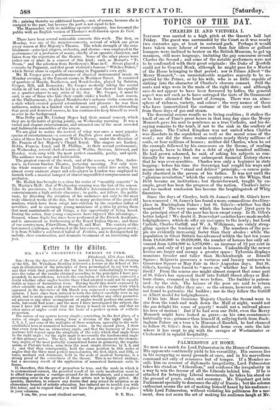retter tu the (Patin.
MR. IIAY'S GEOMETRICAL THEORY OF FORM.
Edinburgh, 171h June 18:51.
Sin—From the Spectator of the 7th instant I learn, that on the evening of the 6th, Mr. Wyndham Harding delivered a lecture at the School of De- sign in illustration of the principles of form promulgated in my last work, and that while that gentleman did me the honour unhesitatingly to recog- nize the value of the results obtained according to the principles I have pro- pounded, he nevertheless, towards the conclusion of his lecture, expressed a doubt whether other angles besides those I had adopted would not be equally fertile as bases of harmonious form. Having heard this doubt expressed by other scientific men, and as in your excellent notice of the same work which appeared in the Spectator of 8th March you expressed a somewhat similar opinion, I have since been induced to turn the subject carefully over in my mind, and to make many attempts to ascertain whether any other geometri- cal process or any other arrangement of angles would prauce the same re- sults, but could find none; and the more I have investigated the subject, the more I have felt convinced that my theory is based on truth, and that no other series of angles could form the basis of a perfect system of wsthetie proportion. The nature of my system is very simple; consisting, in the first place, of a series of simple angles arising from a division of the right angle by 2, 3, 5, 7, and some of the multiples of these numbers, agreeably to the well- established laws of numerical harmonic ratio. In the second place, I show that every form has an elementary angle, and that the harmony of its pro- portions will depend upon the simplicity of the ratio which that angle bears to the right angle ; for the right angle is necessarily the fundamental angle of this primary series. The fact, that by such an arrangement the elemen- tary angles of the most perfectly symmetrical forms in geometry, the regular solids, or Platonic bodies, arise from the most simple divisions by 2, 3, and 5; and that they consequently, hold the same position in this series of angles that the three most perfect musical notes, the first, third, and fifth, or tonic, mcdiant and dominant, hold in the scale of musical harmony, is a strong proof of the correctness of the theory. This is no forced analogy, but a necessary result of the application of numerical harmonic ratio to forms.
If therefore, this theory of proportion be true, and the mode in which it
is systematized correct, the practical result of its early inculcation must be to afford true genius a vantage-ground for its development, and a means of preventing error in the practice of those artists not so highly gifted. My anxiety, therefore, to remove any doubts that may retard its adoption as an elementary branch of artistic education, has induced me to trouble you with this letter, and to request that you will have the goodness to give it a place in your columns. I am, Sir, your most obedient servant, D. R. RAY.


























 Previous page
Previous page